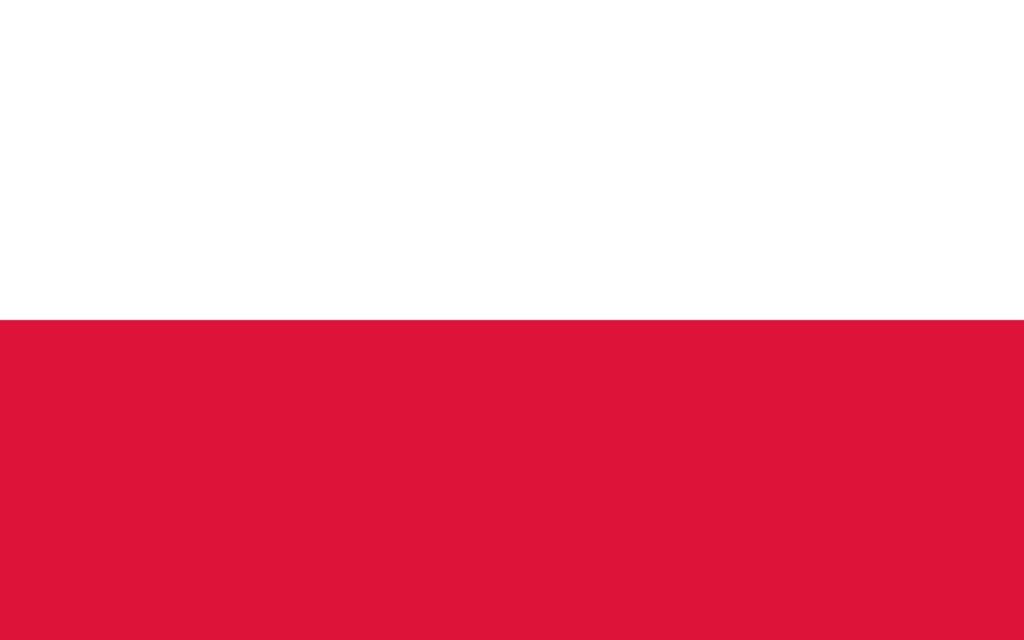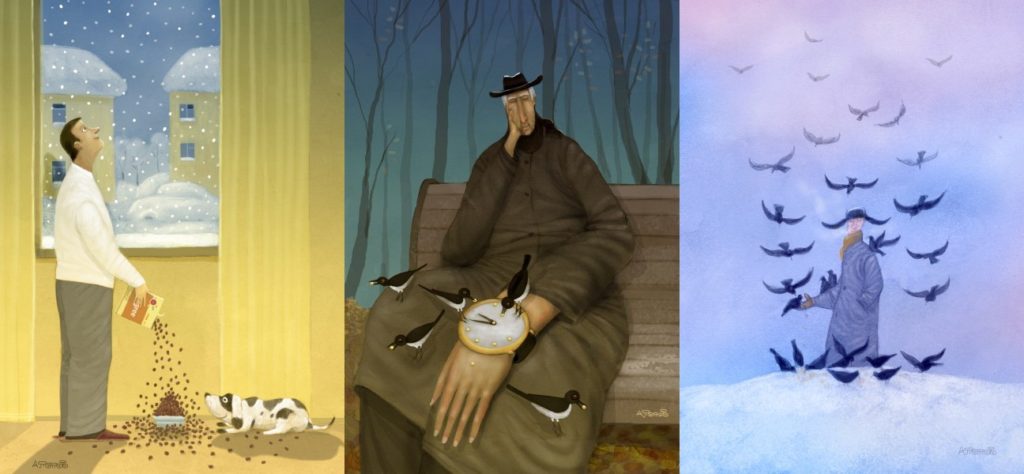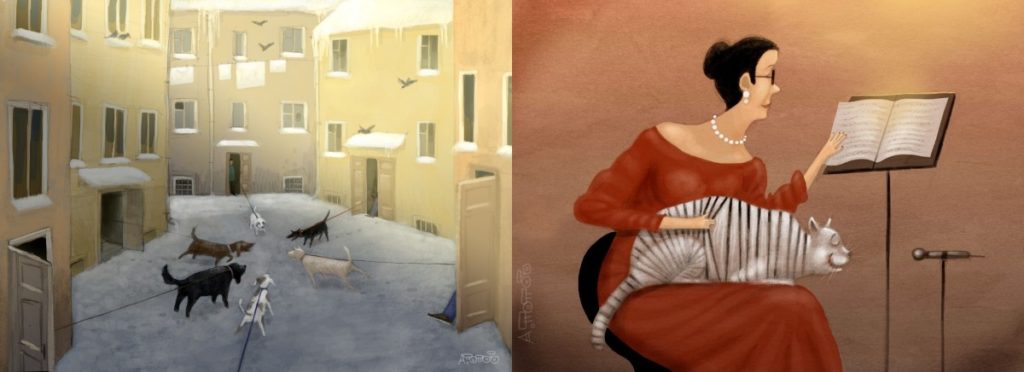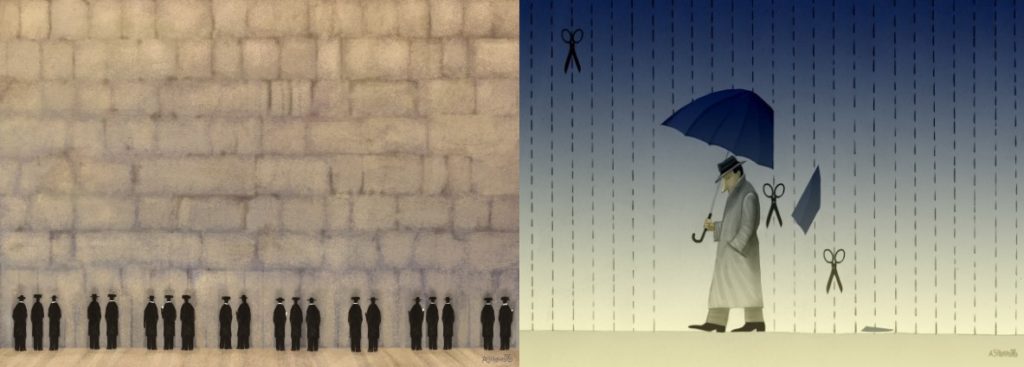In his pictures our every-day trivial moments become significant. People are depicted according to the most basic rhythm – night and day, atmospheric phenomena and seasons of the year. Actually they face the most important issues. Between spirit and body, senses and reflection, life and art, microcosmoses of their apartments, beds or chairs and macrocosmoses. One would even dare to say solemnly – as a matter of fact Popov adds a lot of humorous solemnity to his works – between tawdriness and grandness. But what seems to be the most crucial, these extremes of our existence are combined in such a natural and pleasant way. Certainly enough, it is thanks to a ubiquitous metaphor.
The story main characters are most often a woman and a man, chosen carefully and deliberately to match each and every anecdote, they are of various ages, features, perhaps of different origins, at the same time they are universal. They have comprised a very rich gallery of various human types. The obese, strong, and if a topic demands it, handsome sensual bodies of heroes actually drag them down to the ground. And their faces? Occasionally these characteristic oblong visages with narrow and long noses, specific lips and half-closed eyes, refer us slightly to icons. Although on the other hand, the author’s imagination and life itself place the characters in such situations that their grimaces exceed much beyond philosophical reflection.
It is a simple and humble world, but at the same time an extremely “rich” one. It is plenteous with concepts, full of colours and shines created in a masterful manner. In these works light plays a crucial role. Even a cigarette leads to metaphysics. A flypaper, a dustbin or a bucket are simply beautiful and reach far beyond the prose of life. The surrounding them glow evokes the known associations, but perhaps it is only because Andrei enjoys late night rambling.
As it often happens when one deals with basic issues, quite many of the concepts are situated provocatively close to banality. Popov also seems to like artistic chit-chats. He willingly reaches out for the ready-made images, only to tell their own, totally different version. He applies constant satirical motives as an alphabet. Nevertheless his story, thanks to his exceptional imagination, sense of humour and a beautiful form, is not banal any longer. How many times have cartoonists peeped under a table to see what is going on there? Still, who was the one to come up with an idea to add a crowd of carnival-like, dancing, resembling Sempé’s manner, „light” legs to a dignified, and by the way, very “Russian” couple?
Perhaps this exactly is the greatest secret of these images. Their unpretentiousness. They seem to be so well-known that we can lose something, as they attract us to their complicated world – to say that this world have “hidden depths” is really not enough. We have seen at least a thousand times already how a dog and his master begin to resemble one another. But it is this particular man’s face looking at the snow, turning upwards, similar to a delighted dog’s snout, that makes us pose a question: Is it not so, by chance, that the Almighty is feeding us with a sort of ready-made food? Perhaps he does it equally carelessly being busy with his divine matters? A great force of Popov’s concepts originates in his perfect elaboration of details. The significant name of dog’s food, discreetly covered by a hand, is yet another issue to be considered…
A myth, a parable, a tale, or an essay on human nature – these are comparisons eagerly used by the critics who, in turn, write such essays on the occasion of Popov’s exhibitions. However, they are far away from optimistic lightness of the original.
In Popov’s works even a frying pan with morning scrambled eggs is being transformed into a wide ocean with two floating desert islands, and this precisely cut bite resembles a partly eaten cake or pizza. In the images that are best remembered, metaphors quickly replace one another, and depict apparently inexpressible gamut of various emotions. Is this falling-into-pieces/microcosmoses plate a tale of female fury which is actually spreading or fading away? Or perhaps it is about frittering oneself and one’s emotions away?
A sequence of repeated elements is a frequent pattern in compositions of his images. Maybe it is just the influence of music. Popov admits that he listens to music when drawing. A joke which “translates” a raw of similar figures into a music association we will also find within this exhibition. But it may as well be a self-reflection that appears in Popov’s works on the margin of other matters. It is so because Andrei’s pictures are stories about life but also, or even foremost, about the act of creation. The sailor who falls into pieces of his telnyashka, a “torn away” or “bent” corner of a page, all quotations, and last but not least, a gorgeous “clown with a teddy-bear”. Everything in his world stresses this world’s artificiality and convention. Its existence on the borderline between art and life. Popov aims towards painting, still he executes his visions with the aim of a tablet. And it is right about the qualities of this tool that he tells us about in so many different ways in his pictures.
A dissonance that sneaks into this world of order, an apparently tiny change which turns everything “upside down” is the most important topic. It is followed by the most revolting twist of action in these still, elegant, only apparently static images. The artist is interested more in the moments “before”, and especially “after”, than the events themselves. Though he also likes paradoxes. Let us have a look at how dramatic the seemingly tranquil moments before falling asleep may be…
Popov is not alone in his poetic and satirical world. There are some allies, even though completely different from him, that keep coming to my mind: Michael Sowa or Florian Doru Crihana. The Poles who are in love with Russian culture cannot break free from certain stereotypes. Some old movies, old school of folk stories illustration, also icons, and finally poetry perhaps, as we deal, mind you, with a poet. The Russians have been practicing daily poetry of this kind for over a hundred years now, let it be starting from Mandelstam and Akhmatova. Let anyone or any generation use their own favourite names in this place. Nevertheless, looking from the neighbourhood distance, you have to notice one thing! Popov, who is recognised and appreciated worldwide, is at the same time very Russian, I guess, in the best meaning of this quality. And in the end one more thing. One of Popov’s exhibitions was entitled “Not a Single Word”. But let’s have a look at this evening drama a rebours: we are perfectly aware of not only HOW MUCH but also WHAT it actually says!
Beata Adamek
ANDREI POPOV
Painter, Cartoon Artist & Illustrator
Andrei Popov was born on 13 February 1970. He began to draw from an early age. His family military background resulted in his education at Mozhaysky Military Air Academy between 1987 and 1992. In 1995 he left the military career to become a free lance cartoon artist. His free lance career took off in 1997 when he began working with a St Petersburg newspaper „Business St Petersburg”. Over the years the artist cooperated with many newspapers and magazines, such as „Business St Petersburg”, „Journalism & Media Market”, „Izvestia-Petesburg”, „Evening St Petersburg”, „Publish”, “Psychologies”. This is just a short list of all the publications the artist was involved with. He is a member of a „Russian Caricature Club”, an international club „Cartoonion” and a project „Cartoonbank”. Throughout his career, Popovfrequently participated in numerous Russian and International exhibitions and competitions, as a participant, as well as an organiser and a judge. He received top awards for his creations in countries like Italy, Hungary, Turkey, Luxembourg, Denmark, China, Azerbaijan, Belgium and Poland. His other talents include book illustrating and creating prints for the fashion industry. In 2012 Andrei published his first album as part of the series „Gallery of Caricature Masters”. He lives and works in St Petersburg.




